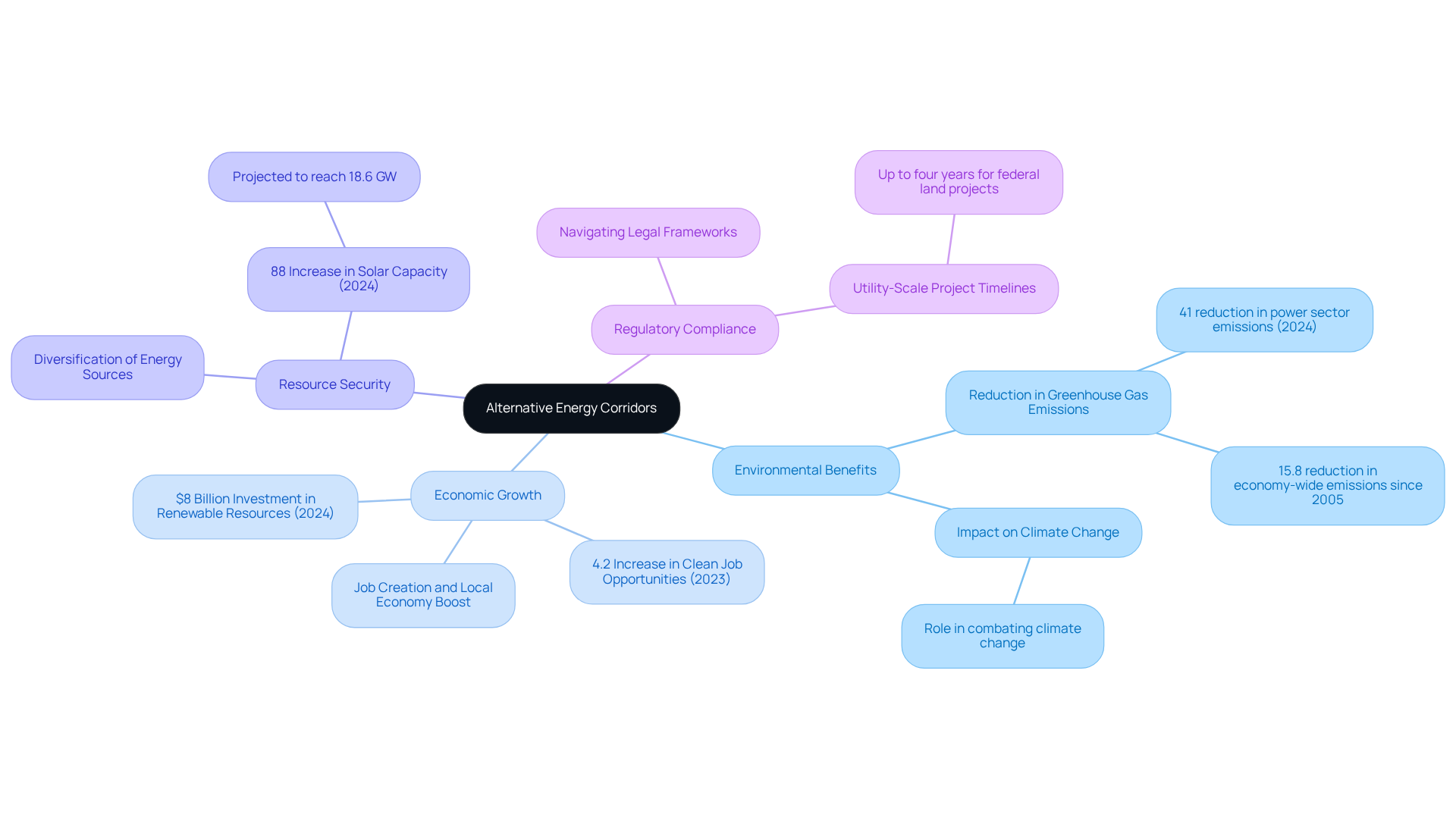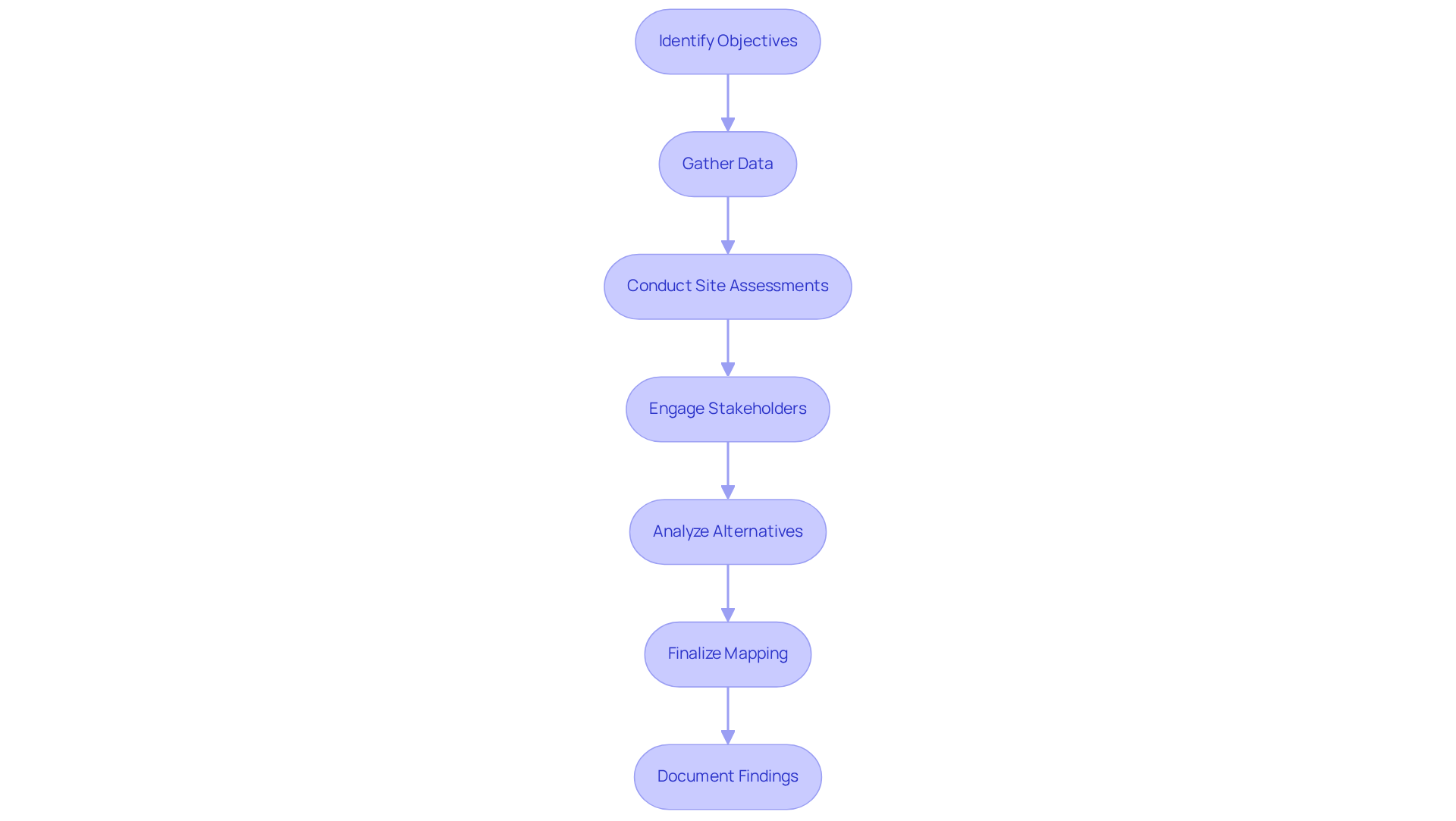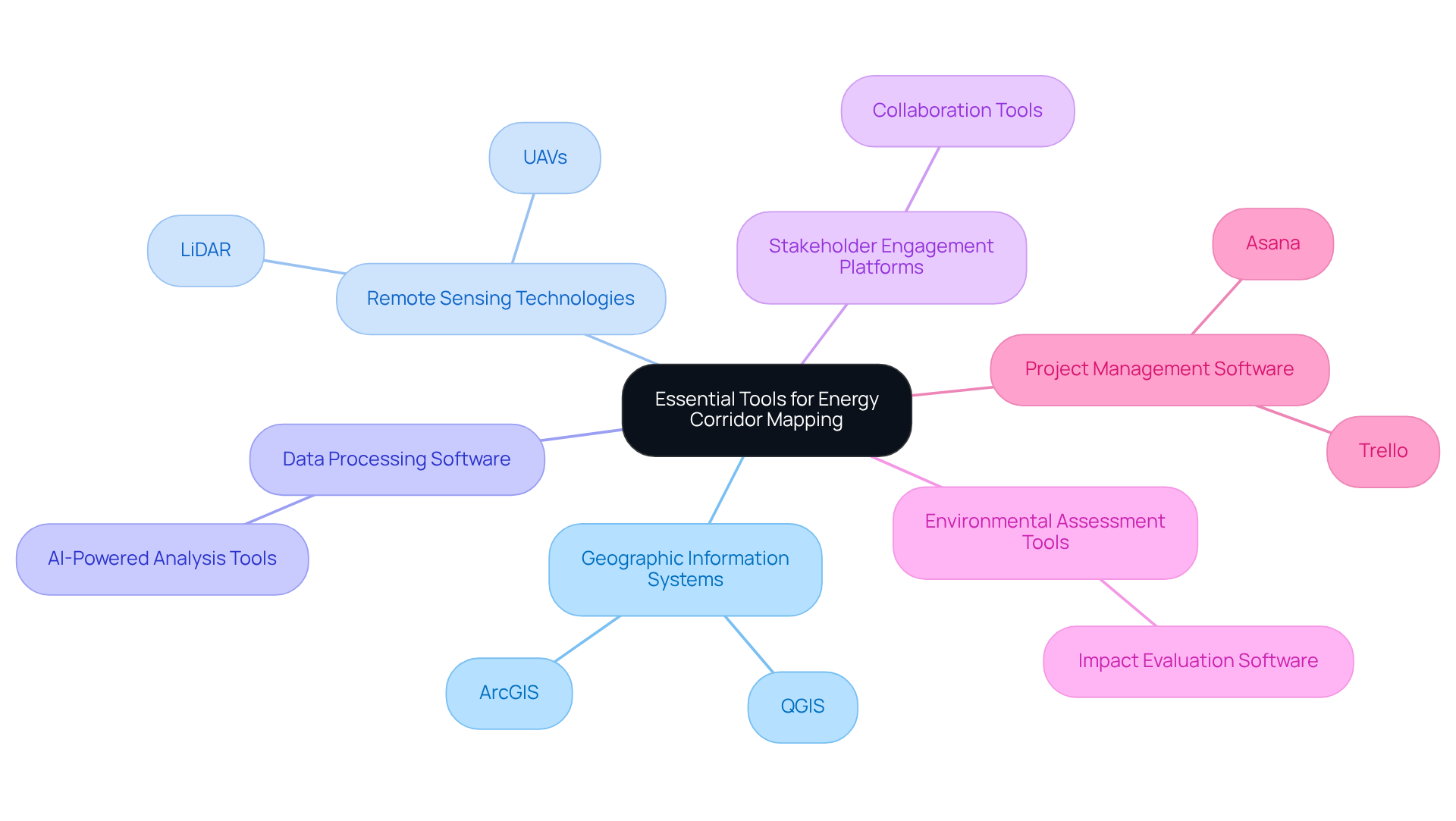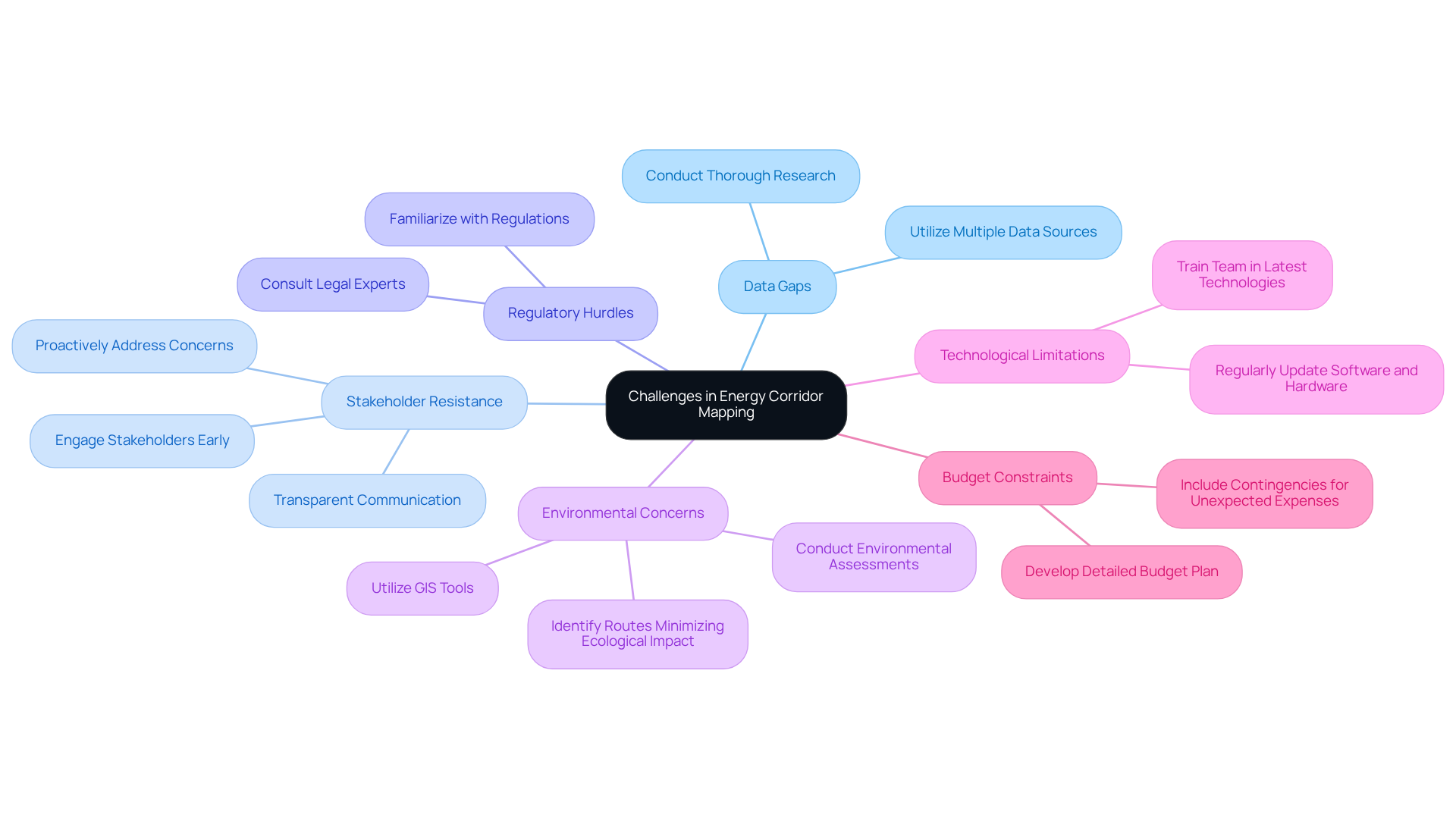Overview
This article addresses the critical steps, tools, and solutions required for effective alternative energy corridor mapping, a process essential for optimizing the transmission of renewable energy resources. It highlights the necessity of structured mapping processes and advanced technologies, including GIS and remote sensing, to tackle challenges such as:
- Data gaps
- Stakeholder resistance
- Regulatory compliance
These elements are vital for successfully integrating renewable energy into existing infrastructures.
Introduction
The transition to renewable energy is not merely a trend; it is an essential requirement for a sustainable future. Alternative energy corridors are instrumental in this transition, acting as crucial conduits for the effective transmission of renewable resources such as solar and wind energy. By strategically mapping these corridors, stakeholders can unlock substantial environmental, economic, and regulatory advantages. Yet, the journey is not without its obstacles—ranging from data gaps to regulatory challenges—that can complicate the implementation process.
How can industry professionals adeptly navigate these complexities to ensure successful energy corridor mapping?
Define Alternative Energy Corridors and Their Importance
Alternative resource routes represent crucial pathways for the transmission of renewable resources, such as solar, wind, and bioenergy. These routes are essential for connecting power generation sites with consumption hubs, significantly enhancing the efficiency of power distribution. Their importance is underscored by several key factors:
- Environmental Benefits: The promotion of renewable resources through these pathways leads to a notable reduction in greenhouse gas emissions, playing a vital role in combating climate change. In 2024, the U.S. achieved a remarkable 41% reduction in power sector emissions, while economy-wide emissions fell by 15.8% compared to 2005 levels, underscoring the effectiveness of these initiatives.
- Economic Growth: Alternative power pathways foster the development of new energy projects, which in turn create jobs and invigorate local economies. In 2024, investments in renewable resources soared to $8 billion, resulting in a 4.2% increase in clean job opportunities in 2023—significantly outpacing overall economic growth.
- Resource Security: By diversifying energy sources and enhancing infrastructure, these routes bolster national resource security. The U.S. is expected to see a rise in renewable power capacity, with solar capacity alone projected to expand by 88%, reaching 18.6 GW in 2024, thereby ensuring a more resilient energy landscape.
- Regulatory Compliance: Navigating the legal frameworks surrounding these pathways is crucial for the successful implementation of projects. A thorough understanding of these regulations can streamline processes and reduce potential delays, particularly in a context where constructing utility-scale projects on federal lands may take up to four years.
In conclusion, the mapping of alternative energy corridors is indispensable in the transition to a sustainable future, making alternative energy corridor mapping a priority for industry professionals. Their contributions to emission reductions, economic growth, resource independence, and regulatory compliance are essential and cannot be overstated.

Outline the Step-by-Step Process for Mapping Energy Corridors
The process of alternative energy corridor mapping is critical for ensuring efficiency and effectiveness in energy transmission. To achieve this, a structured approach is essential. Here are the essential steps:
- Identify Objectives: Clearly define the project's goals, such as pinpointing potential routes for sustainable power transmission or evaluating environmental impacts.
- Gather Data: Collect pertinent data, including topographic maps, land use patterns, and existing infrastructure details. Employ GIS tools to streamline data compilation and enhance accuracy. Notably, grid investment needs to nearly double by 2030 to meet growing energy demands, underscoring the importance of effective mapping.
- Conduct Site Assessments: Execute field surveys to evaluate the physical characteristics of potential pathway routes, considering environmental and social factors that may impact project viability. Thorough environmental assessments are crucial for identifying sensitive habitats and species.
- Engage Stakeholders: Foster collaboration with local communities, government agencies, and other parties to gather insights and address concerns related to the proposed routes. Effective communication is crucial for project acceptance and success, as proactive engagement enhances sustainability.
- Analyze Alternatives: Utilize GIS software to evaluate various routing options based on criteria such as cost, environmental impact, and regulatory compliance. This analysis aids in recognizing the most appropriate pathway routes. Case studies, such as the Integrated GIS for Zoning Compliance, demonstrate how advanced GIS tools can improve zoning compliance in land development.
- Finalize Mapping: Develop comprehensive maps that delineate the proposed corridors, integrating stakeholder feedback and ensuring adherence to legal requirements.
- Document Findings: Compile a detailed report that outlines the process of visualization, data analysis, and stakeholder engagement outcomes. This documentation supports future project phases and provides a reference for decision-making.
Integrating advanced GIS tools has proven effective in enhancing the cartography process, as illustrated by case studies that show improved zoning compliance and stakeholder engagement. By adhering to these best practices, alternative energy corridor mapping can significantly facilitate the successful incorporation of renewable power sources into the existing infrastructure. As David Crane pointed out, the power landscape is evolving, making stakeholder involvement more essential than ever.

Identify Essential Tools and Technologies for Energy Corridor Mapping
To effectively perform alternative energy corridor mapping, it is essential to leverage a combination of advanced tools and technologies.
- Geographic Information Systems (GIS) serve as a cornerstone for analyzing spatial data and generating detailed maps. Leading options include ArcGIS and QGIS, both widely recognized for their robust capabilities in energy route assessments. As Jack Dangermond from Esri noted, "The application of GIS is limited only by the imagination of those who use it," underscoring the innovative potential of these tools.
- Remote Sensing Technologies such as LiDAR (Light Detection and Ranging) and UAVs (Unmanned Aerial Vehicles) provide high-resolution data crucial for terrain analysis and corridor evaluation. These technologies enhance the precision of charting by capturing detailed topographical information.
- Data Processing Software powered by artificial intelligence streamlines data analysis, significantly improving the precision of title research and environmental assessments. This integration not only enhances efficiency but also supports informed decision-making.
- Stakeholder Engagement Platforms are vital for facilitating communication and collaboration with stakeholders. By incorporating diverse perspectives, these platforms enhance the planning process and ensure that all relevant voices are heard. Involving stakeholders is essential, especially given the increasing demand for creative solutions in utility route development.
- Environmental Assessment Tools designed to evaluate environmental impacts are crucial for ensuring compliance with regulations and promoting sustainable practices. These tools help identify potential ecological concerns early in the planning process.
- Project Management Software such as Trello or Asana aids in organizing tasks, timelines, and team collaboration during the planning process, ensuring that projects remain on schedule and meet deadlines.
The combination of these technologies not only improves the surveying process but also addresses the rising need for innovative solutions in alternative energy corridor mapping and utility route development. Notably, the GIS market is anticipated to expand to USD 14.5 billion by 2025, growing at a rate of 12.4% throughout the forecast period.

Troubleshoot Common Challenges in Energy Corridor Mapping
The challenges presented by alternative energy corridor mapping require strategic solutions. Understanding these common issues is crucial for effective troubleshooting.
- Data Gaps: Incomplete or outdated data can hinder mapping efforts. Conducting thorough research and utilizing multiple data sources is essential to fill these gaps.
- Stakeholder Resistance: Engaging stakeholders early in the process can significantly mitigate resistance. Employ transparent communication and proactively address any concerns.
- Regulatory Hurdles: Navigating complex regulations can be daunting. Familiarize yourself with local, state, and federal requirements, and consider consulting legal experts when necessary to ensure compliance.
- Environmental Concerns: Environmental assessments may reveal sensitive areas that complicate routing. Utilize GIS tools to support alternative energy corridor mapping that identifies routes minimizing ecological impact, ensuring responsible development.
- Technological Limitations: Ensure your team is well-trained in the latest technologies and tools. Regularly updating software and hardware is vital for maintaining efficiency and accuracy in mapping efforts.
- Budget Constraints: Mapping projects can often exceed budgets due to unforeseen challenges. It is prudent to develop a detailed budget plan that includes contingencies for unexpected expenses, ensuring financial stability throughout the project.

Conclusion
Alternative energy corridors are essential pathways in the transition to renewable energy, enabling the effective transmission of resources like solar and wind energy. Their importance is highlighted by their capacity to lower emissions, stimulate economic growth, enhance resource security, and ensure adherence to regulatory frameworks. As industry professionals focus on mapping these corridors, grasping their diverse benefits is crucial for advancing toward a sustainable energy future.
This article presents a thorough approach to mapping energy corridors, outlining a systematic process that includes:
- Defining objectives
- Gathering data
- Conducting site assessments
- Engaging stakeholders
- Analyzing alternatives
- Finalizing mapping
- Documenting findings
It also emphasizes the vital tools and technologies—such as GIS, remote sensing, and data processing software—that facilitate the mapping process and tackle common challenges like data gaps and regulatory hurdles. By utilizing these insights, stakeholders can adeptly navigate the complexities tied to alternative energy corridor mapping.
Ultimately, the effective implementation of alternative energy corridors transcends mere technical execution; it signifies a pivotal step toward a sustainable future. Engaging with innovative tools and collaborative practices is essential for overcoming obstacles and maximizing the potential of renewable energy. As the demand for clean energy solutions escalates, the dedication to mapping these corridors will be instrumental in shaping a resilient and environmentally responsible energy landscape.
Frequently Asked Questions
What are alternative energy corridors?
Alternative energy corridors are crucial pathways for the transmission of renewable resources, such as solar, wind, and bioenergy, connecting power generation sites with consumption hubs to enhance the efficiency of power distribution.
Why are alternative energy corridors important?
They are important due to their environmental benefits, contribution to economic growth, enhancement of resource security, and necessity for regulatory compliance.
How do alternative energy corridors benefit the environment?
They promote renewable resources, leading to a significant reduction in greenhouse gas emissions, which is vital in combating climate change. For instance, in 2024, the U.S. achieved a 41% reduction in power sector emissions compared to 2005 levels.
What economic impact do alternative energy corridors have?
They foster the development of new energy projects, creating jobs and invigorating local economies. In 2024, investments in renewable resources reached $8 billion, resulting in a 4.2% increase in clean job opportunities in 2023.
How do alternative energy corridors enhance resource security?
By diversifying energy sources and improving infrastructure, these corridors strengthen national resource security. The U.S. is expected to see a significant increase in renewable power capacity, particularly solar, which is projected to expand by 88% by 2024.
What role do regulations play in alternative energy corridors?
Understanding the legal frameworks surrounding these pathways is crucial for successful project implementation, as it can streamline processes and reduce delays, especially since constructing utility-scale projects on federal lands may take up to four years.
What is the overall significance of mapping alternative energy corridors?
Mapping these corridors is essential for transitioning to a sustainable future, as they contribute to emission reductions, economic growth, resource independence, and regulatory compliance.
List of Sources
- Define Alternative Energy Corridors and Their Importance
- 6 Takeaways from the 2025 Sustainable Energy in America Factbook (https://bcse.org/6-takeaways-2025-sustainable-energy-america-factbook)
- The Executive Headlines - Top business magazine & news headlines sources (https://executiveheadlines.com/erp/quotes-on-sustainable-energy)
- 2025 Renewable Energy Industry Outlook (https://www2.deloitte.com/us/en/insights/industry/renewable-energy/renewable-energy-industry-outlook.html)
- 60 Quotes About the Future of Renewable Energy (https://deliberatedirections.com/renewable-energy-quotes)
- Outline the Step-by-Step Process for Mapping Energy Corridors
- Best Practices for Energy Corridor Management: Proven Strategies for Success (https://blog.harbingerland.com/best-practices-for-energy-corridor-management-proven-strategies-for-success)
- utilitydive.com (https://utilitydive.com/news/12-unforgettable-quotes-from-nrg-energy-ceo-david-crane/227117)
- 10 Quotes Concerning Energy Transformation from the ARPA-E Summit (https://powermag.com/10-quotes-concerning-energy-transformation-from-the-arpa-e-summit)
- National Interest Electric Transmission Corridor Designation Process (https://energy.gov/gdo/national-interest-electric-transmission-corridor-designation-process)
- Opinion: Best quotes from energy execs in Houston for CERAWeek 2023 (https://houstonchronicle.com/projects/2023/ceraweek-granholm-energy-chevron-wirth-bell-utilities)
- Identify Essential Tools and Technologies for Energy Corridor Mapping
- GIS and Cartography Quotes (https://geographyrealm.com/gis-quotes)
- National Interest Electric Transmission Corridor Designation Process (https://energy.gov/gdo/national-interest-electric-transmission-corridor-designation-process)
- Geographic Information System Market Industry Report Global Growth Drivers, 2032 (https://marketsandmarkets.com/Market-Reports/geographic-information-system-market-55818039.html)
- 30 Best Jack Dangermond Quotes With Image | Bookey (https://bookey.app/quote-author/jack-dangermond)




